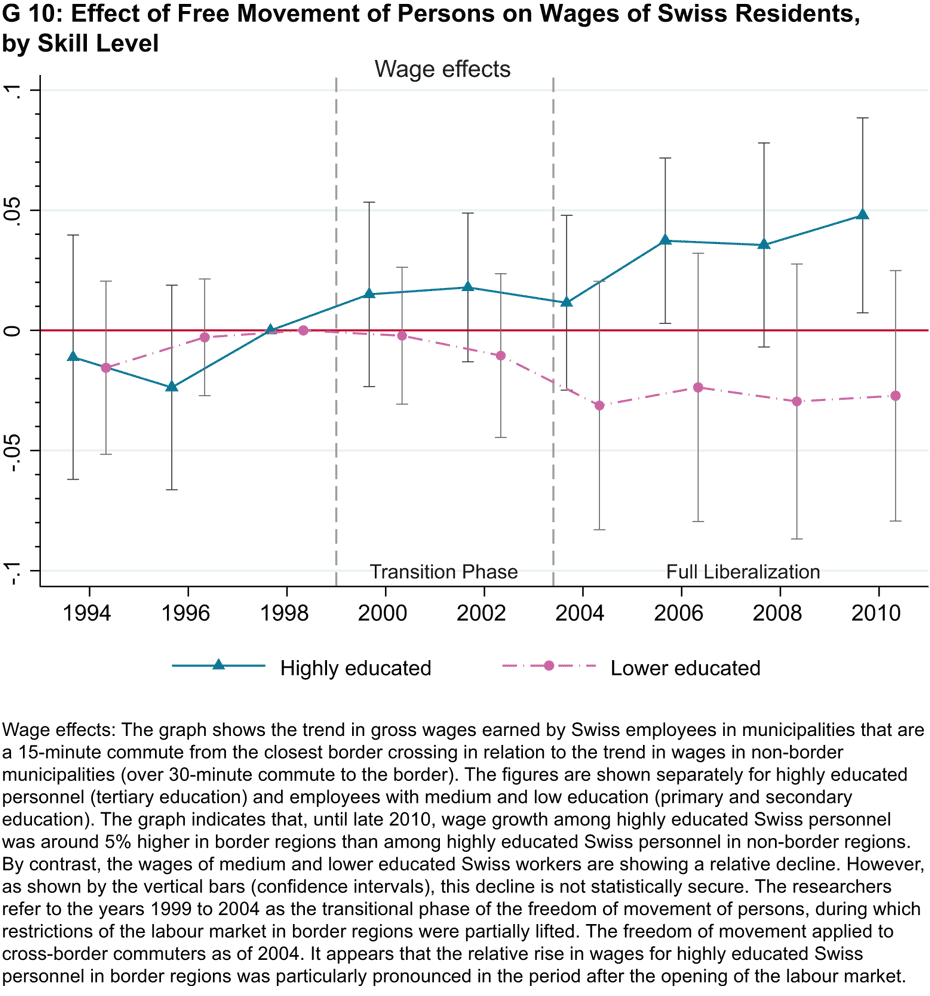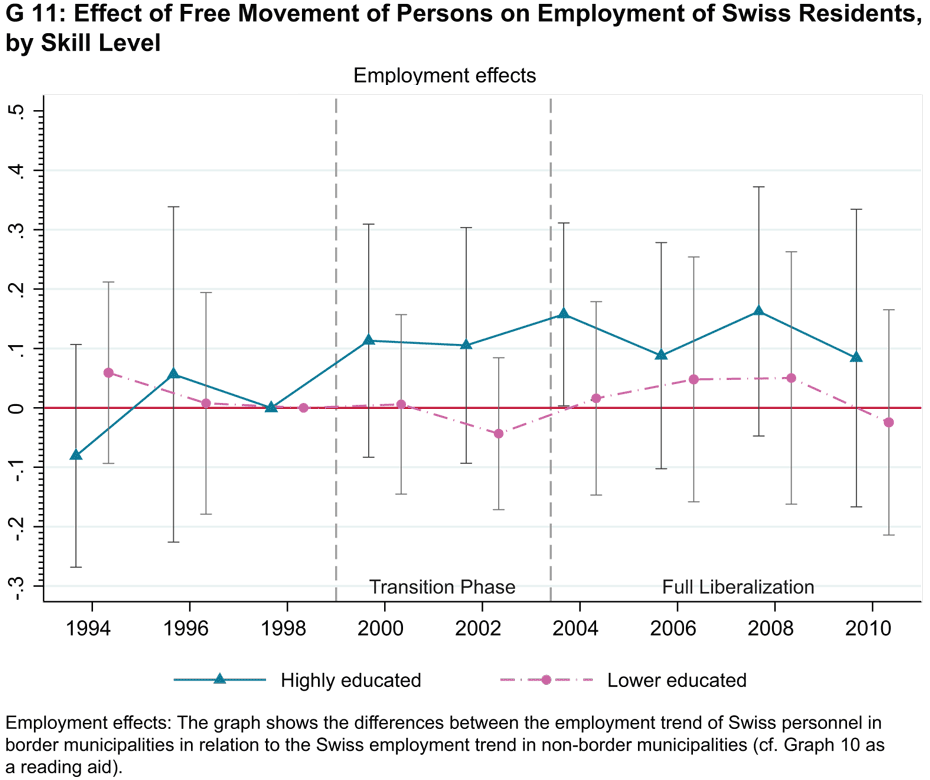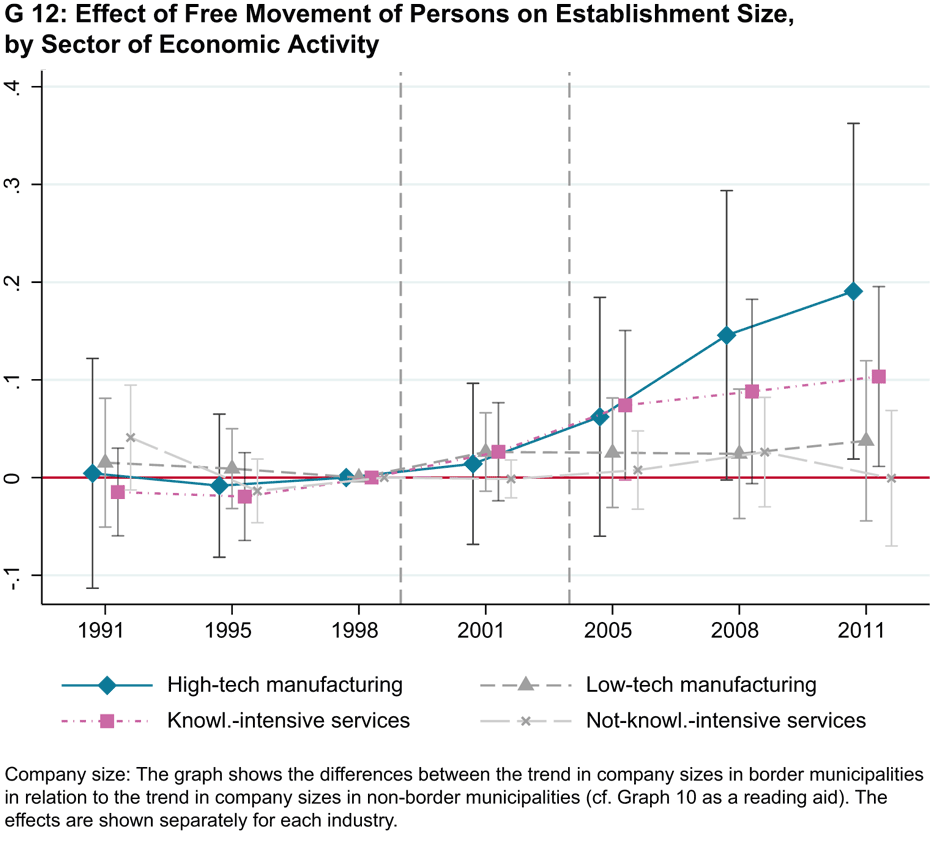The Consequences of the Free Movement of Persons for the Labour Market
- Labour Market
- KOF Bulletin
Has the free movement of persons resulted in new jobs or has it simply shifted jobs from local residents to immigrants? Has it raised salaries among local residents or reduced them? These are the questions that were investigated in the context of an extensive research programme in which three KOF researchers played a leading role.
The adoption of the anti-mass immigration initiative seems to indicate anxiety about the consequences of immigration among the Swiss population. A possible consequence of immigration is ‘displacement’ from the labour market. This fear is understandable since the abolition of immigration restrictions leads to an expansion of the labour force available to companies. In theory, such an expansion of the labour supply has the potential to reduce wages and job opportunities for the local population. However, many entrepreneurs state that unrestricted access to qualified personnel is a central factor ensuring their success (Eichler et al., 2013).
Which of the two sides is right? This is the question investigated by an extensive research programme in which three KOF researchers played a leading role (cf. Beerli et al. 2018). The researchers took advantage of the fact that the gradual opening of the Swiss labour market happened earlier and to a more significant degree in border regions than in other Swiss regions, since the free movement of persons opened the Swiss labour market not only to immigrants but also to cross-border commuters. Today, there are 150,000 more border crossers working for Swiss companies than in early 2002 – which is close to twice the original number. It comes with the territory that this increase happened almost exclusively in border regions.
The study conducted by Beerli et al. (2018) shows that, after 2002, employment of both cross-border commuters and foreign workers in general – i.e. border crossers plus immigrants – increased substantially faster in border areas than in more distant regions. These results seem to indicate that the most immediate impact of the free movement of persons, namely an increase in employment of foreigners in Switzerland, was more pronounced in border regions. In their study of the effects of the free movement of persons, the researchers therefore concentrated on comparing border and non-border regions in Switzerland. This comparison allows for statistical control of other trends that affect both regions to a similar extent.
Few indications of wage pressure
As a first step, the researchers compared the wage and employment trends among local populations in border and non-border regions. They found that both wages and employment of Swiss employees had grown at virtually the same rate in both regions. Hence, despite the substantially larger rise in foreign employment, the high wage level in Switzerland and the job opportunities of the Swiss population in the border regions did not come under increased pressure.
On the contrary: The researchers found signs that the wages earned by well-qualified Swiss employees in border regions increased faster than in non-border regions despite greater immigration pressure (see G 10). This result is all the more remarkable since the majority of foreign employees who found work in border regions in the course of the free movement agreement were also well qualified. It can be explained by the fact that demand, and hence the number of jobs available to well-qualified personnel, also recorded exceptional growth in border regions (see G 11). In fact, one-third of the rise in wages of well-qualified Swiss employees in border regions is due to increased opportunities to find managerial positions.
To understand why more jobs were created for highly educated personnel, the researchers then looked at the companies involved. They found strong evidence that better access to foreign personnel had a positive impact on companies in border areas. In the years 2002 to 2007 in particular, companies in border regions recorded stronger growth than those in non-border regions, both in terms of employment and turnover. Unsurprisingly, this growth effect is particularly evident in the case of companies that are active in sectors with a high demand for well-qualified personnel. According to the researchers, these sectors comprise the high-tech industry, including among others the chemical, pharmaceutical and engineering industry, as well as knowledge-intensive service industries, such as insurance, IT and healthcare (see G 12).
Foreign personnel acted as a growth driver
All in all, Swiss companies in the border regions have benefited significantly from better access to EU labour. Without recourse to foreign personnel, companies would have expanded less substantially and would be less numerous. This supports the assumption that EU labour was indeed an important factor for the success of Swiss companies in the period after the introduction of free movement. In addition, the effects on companies were responsible for pushing up demand for labour at the same time as the labour supply increased: Companies created jobs in Switzerland that would not exist without the free movement of persons. Consequently, immigration resulted neither in displacement nor in widespread wage pressure.
At the same time, the research results show that the companies were in part responsible for the substantial influx of foreigners in the years following the opening of the labour market. The results suggest that immigration to Switzerland cannot be curtailed without affecting companies’ employment growth and slowing down economic development – immigration and employment growth are, after all, reverse sides of the same coin.
This article was written in the context of a hearing of economists organised by Avenir Suisse and Economiesuisse. A detailed version of the text can be found here.
Contacts
KOF Konjunkturforschungsstelle
Leonhardstrasse 21
8092
Zürich
Switzerland
KOF FB KOF Lab
Leonhardstrasse 21
8092
Zürich
Switzerland



